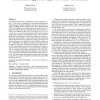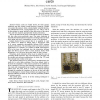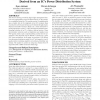63 search results - page 10 / 13 » Protecting Cryptographic Keys from Memory Disclosure Attacks |
ASPLOS
2012
ACM
12 years 3 months ago
2012
ACM
Virtualization has become a standard part of many computer systems. A key part of virtualization is the all-powerful hypervisor which manages the physical platform and can access ...
SISW
2003
IEEE
14 years 18 days ago
2003
IEEE
— Smart cards are widely known for their tamper resistance, but only contain a small amount of memory. Though very small, this memory often contains highly valuable information (...
DAC
2010
ACM
13 years 11 months ago
2010
ACM
The level of security provided by digital rights management functions and cryptographic protocols depend heavily on the security of an embedded secret key. The current practice of...
KDD
2010
ACM
13 years 11 months ago
2010
ACM
The security demands on modern system administration are enormous and getting worse. Chief among these demands, administrators must monitor the continual ongoing disclosure of sof...
ASIACRYPT
2000
Springer
13 years 11 months ago
2000
Springer
The mobile agent is a fundamental building block of the mobile computing paradigm. In mobile agent security, oblivious transfer (OT) from a trusted party can be used to protect th...



